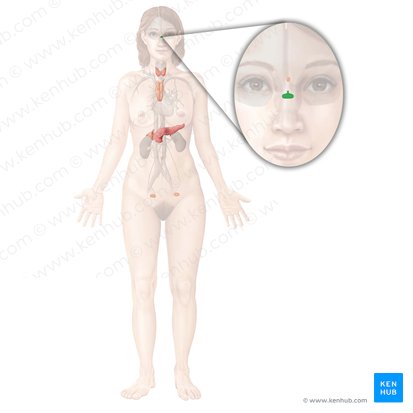Organs of the endocrine system

The endocrine system is a collection of glands. These glands secrete a variety of hormones, which travel to specific target organs via the bloodstream. Hormones have specific functions such as regulating growth, metabolism, temperature and reproductive development. Like the nervous system, the endocrine system acts as a signaling pathway, although hormones are slower acting than nerve impulses.
Endocrine signals can last from a few hours to a few weeks. The main control center for the organs in the endocrine system is the hypothalamus in the brain. The field of medicine concerned with the endocrine system is known as endocrinology.
| Hypothalamus | Borders: anteriorly – anterior commissure, lamina terminalis, optic chiasm; posteroinferiorly – posterior perforated substance; inferiorly – infundibular stalk; superiorly – hypothalamic sulcus and the base of the third ventricle Structure: chiasmatic region, tuberal region, mammillary bodies Function: produces releasing and inhibiting hormones that affect the pituitary gland Hormones: anti-diuretic (ADH), corticotropin-releasing (CRH), gonadotropin-releasing (GnRH), growth hormone-releasing and -inhibiting (GHRH and GHIH), oxytocine, prolactine-releasing and -inhibiting (PRH and PIH), thyrotropine-releasing (TRH) |
| Hypophysis | Location: pituitary fossa, connected to hypothalamus via infundibulum Structure: adenohypophysis, neurohypophysis Function: produces stimulating-hormones that affect endocrine glands of the body Hormones of adenohypophysis: human-growth hormone (hGH), thyroid-stimulating (TSH), follicle-stimulating (FSH), luteinizing (LH), prolactin (PRL), adenocorticotropic (ACTH), melanocyte-stimulating (MSH) Hormones of neurohypophysis: oxytocin, antidiuretic hormone (ADH) |
| Pineal gland | Location: between superior colliculi Function: regulates sleep-wake cycle Hormone: melatonin |
| Thyroid gland | Location: anterior surface of neck at levels C5-T1 Structure: left lobe, right lobe, isthmus (connects the lobes) Function: regulates metabolysm (by enhancing it) Hormones: thyroxine (T4), triiodthyronine (T3), calcitonine |
| Parathyroid glands | Location: posteriorly to the lobes of thyroid gland Function: regulates blood levels of calcium (by increasing it) Hormone: parathyroid hormone |
| Endocrine pancreas and gastric mucosa | Location: Langerhans islets of the pancreatic tissue, gastric mucosa Function: regulates blood levels of glucose, regulates digestion Hormones: insulin, glucagone, gastrin, secretin, ghrelin, motilin, cholecystokinine, gastric inhibitory polypeptide |
| Adrenal glands | Location: superior poles of kidneys Structure: adrenal cortex (secretes glucocorticoids and mineralocorticoids), adrenal medulla (secretes biogene amines) Function: regulates blood pressure, electrolyte balance, stress response Hormones: glucocorticoids – cortisol, corticosterone; mineralocorticoid – aldosteron; biogene amines – epinephrine, norepinephrine, dopamine |
| Gonads | Function: regulates sexual development, behaviour and characteristics; regulates gametogenesis Hormones of testes: testosterone Hormones of ovaries: estrogen, progesterone |
| Clinical relations | Hyperfunction, hypofunction, adenoma, carcinoma |
This article will discuss all of the important anatomical and functional aspects of endocrine system.
Organs of the endocrine system
Endocrine glands tend to be vascular and do not have ducts. Ducts are instead found in exocrine glands, which produce hormonal signals outside of the body. The hormones of endocrine glands are stored in vacuoles or granules, ready to be released.
Endocrine glands are found throughout the body and have a variety of different roles. The key endocrine glands and organs are listed below:
- Hypothalamus
- Pineal gland
- Pituitary gland
- Thyroid gland
- Parathyroid gland
- Ovaries
- Testes
- Pancreas
- Adrenal glands
- Gastrointestinal tract
Hypothalamus
Borders
The hypothalamus is an almond-sized structure in the limbic system of the brain, and the endocrine system’s control center. Its borders are the following:
- Anteriorly:anterior commissure, lamina terminalis, and optic chiasm
- Posteroinferiorly: the posterior perforated substance
- Inferiorly: the infundibular stalk
- Superiorly: the hypothalamic sulcus and the base of the third ventricle